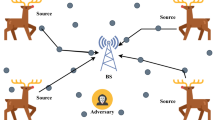Abstract
Source-location privacy is a critical security property in event-surveillance systems. However, due to the characteristics of surveillance systems, e.g., resource constraints, diverse privacy requirements and large-scale network, the existing anonymity mechanisms cannot effectively deal with the problem of source-location privacy protection. There is an imbalance on network load and transmission latency for most of the existing anonymity schemes, which causes “funnel effect” and conflicts with anonymity. This paper proposes the dynamic optimal mix-ring-based source-location anonymity protocol, DORing. In this scheme, we first set the dynamic optimal mix-ring to collect and mix the network traffic, which can satisfy the diverse QoS requirements for all the packets. Secondly, we propose the sector-based anonymity assess to control the process of mixing in order to filter out the dummy packets and deliver the authentic packets to sink. Finally, the location of mix-ring is adjusted to balance network energy consumption, prolong the lifetime of the network and resist global attack. The simulation results demonstrate that DORing is very efficient in balancing energy consumption and transmission latency and can significantly prolong survival period of the network and ensure security as well as latency to satisfy the packets’ requirements.












Similar content being viewed by others
References
Winkler T, Rinner B et al (2014) Security and privacy protection in visual sensor networks: a survey. ACM Comput Surv (CSUR) 47(1):2–42
Sun Y et al (2016) Internet of things and big data analytics for smart and connected communities. IEEE Access 4(2016):766–773
Sun Y, Jara AJ (2014) An extensible and active semantic model of information organizing for the internet of things. Pers Ubiquitous Comput (PUC) 18(8):1821–1833
Guo J, Sun Y et al (2014) Square-root unscented Kalman filtering-based localization and tracking in the internet of things. Pers Ubiquitous Comput (PUC) 18(4):987–996
Long J et al (2015) An energy-efficient and sink-location privacy enhanced scheme for WSNs through ring based routing. J Parallel Distrib Comput 81:47–65
Sun Y et al (2014) Data security and privacy in cloud computing. Int J Distrib Sens Netw 2014(190903):1–9
Xi Y, Schwiebert L, Shi W (2006) Preserving source location privacy in monitoring-based wireless sensor networks. In: IEEE international parallel and distributed processing symposium (IPDPS 2006), pp 1–8
Shaikh RA et al (2010) Achieving network level privacy in wireless sensor networks. Sensors 10(3):1447–1472
Akyildiz IF et al (2002) Wireless sensor networks: a survey. Comput Netw 38(4):393–422
Conti M, Willemsen J, Crispo B (2013) Providing source location privacy in wireless sensor networks: a survey. IEEE Commun Surv Tutor 15(3):1238–1280
Chen H, Lou W (2015) On protecting end-to-end location privacy against local eavesdropper in wireless sensor networks. Pervasive Mob Comput (PMC) 16:36–50
Li Y, Ren J, Wu J (2012) Quantitative measurement and design of source-location privacy schemes for wireless sensor networks. IEEE Trans Parallel Distrib Syst (TPDS) 23(7):1302–1311
Kamat P et al (2005) Enhancing source-Location privacy in sensor network routing. In: IEEE international conference distributed computing systems (ICDCS 2005), pp 599–608
Yao L et al (2015) Protecting source–location privacy based on multirings in wireless sensor networks. Concurr Comput Pract Exp 27:3863–3876
Ren J, Tang D (2011) Combining source-location privacy and routing efficiency in wireless sensor networks. In: IEEE global telecommunications conference (GLOBECOM 2011), pp 1–5
Rios R, Lopez J (2011) Exploiting context-awareness to enhance source-location privacy in wireless sensor networks. Comput J 54(10):1603–1615
Lightfoot L, Li Y, Ren J (2010) Preserving source-location privacy in wireless sensor network using STaR routing. In: IEEE global telecommunications conference (GLOBECOM 2010), pp 1–5
Yao J, Wen G (2008) Preserving source-location privacy in energy-constrained wireless sensor networks. In: IEEE international conference distributed computing systems (ICDCS2008), pp 412–416
Mehta K, Liu D, Wright M (2012) Protecting location privacy in sensor networks against a global eavesdropper. IEEE Trans Mob Comput (TMC) 11(2):320–336
Alomair B et al (2013) Toward a statistical framework for source anonymity in sensor networks. IEEE Trans Mob Comput (TMC) 12(2):248–260
Shao M et al (2008) towards statistically strong source anonymity for sensor networks. In: IEEE international conference on computer communications (INFOCOM 2008), pp 51–55
Zhang Y et al (2010) All proxy scheme for event source anonymity in wireless sensor networks. In: IEEE international conference on intelligent sensors, sensor networks and information processing (ISSNIP 2010), pp 263–268
Jhumka A, Bradbury M, Leeke M (2012) Towards understanding source location privacy in wireless sensor networks through fake sources. In: IEEE international conference on trust, security and privacy in computing and communications (TrustCom 2012), pp 760–768
Ortolani S et al (2011) Events privacy in WSNs: a new model and its application. In: IEEE international symposium world of wireless, mobile and multimedia networks (WoWMoM 2011), pp 1–9
Thomason A et al (2013) Evaluating the impact of broadcast rates and collisions on fake source protocols for source location privacy. In: IEEE international conference on trust, security and privacy in computing and communications (TrustCom 2013), pp 667–674
Mahmoud MM, Shen X (2012) A cloud-based scheme for protecting source-location privacy against hotspot-locating attack in wireless sensor networks. IEEE Trans Parallel Distrib Syst 23(10):1805–1818
Mahmoud ME, Shen X (2012) Secure and efficient source location privacy-preserving scheme for wireless sensor networks. In: IEEE international conference on communications (ICC2012), pp 1123–1127
Guo M et al (2015) In-network trajectory privacy preservation. ACM Comput Surv (CSUR) 48(2):23–29
Roy PK et al (2015) Source location privacy using fake source and phantom routing (FSAPR) technique in wireless sensor networks. Procedia Comput Sci 57:936–941
Acknowledgments
This work was partially supported by the National Key Research Development Program of China (Grant No. 2016YFB0502201), the National Natural Science Foundation of China NSFC (Grant Nos. 41127901-06, 61572370, 61450110441, 61572374, U1135005), Development Program of China “863 Project” (Grant No. 2015AA016004), the Natural Science Foundation of Hubei Province of China (Grant No. 2014CFB191) and the CERNET Next Generation Internet’s Technology Innovation Project (NGII20150612).
Author information
Authors and Affiliations
Corresponding authors
Rights and permissions
About this article
Cite this article
Niu, X., Zhang, Y., Yao, Y. et al. An energy-efficient source-anonymity protocol in surveillance systems. Pers Ubiquit Comput 20, 771–783 (2016). https://doi.org/10.1007/s00779-016-0949-1
Received:
Accepted:
Published:
Issue Date:
DOI: https://doi.org/10.1007/s00779-016-0949-1




